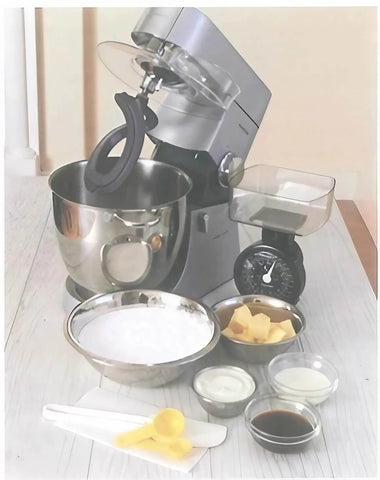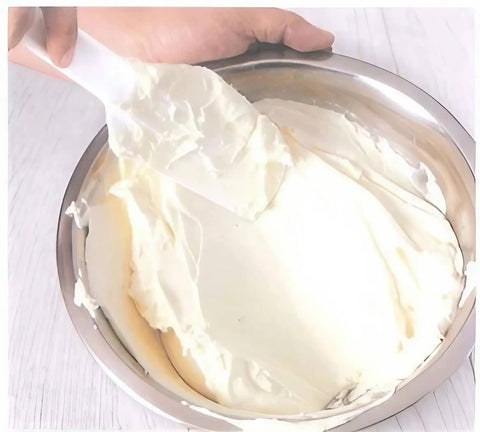How to Whip Perfect Piping Cream?
Share
When making buttercream, one crucial thing to remember is not to overwhip the cream. Overwhipping can result in rough, crumbly petals when piping flowers, and the edges may easily disintegrate during the piping process.
Handheld electric mixers typically have less power compared to stand mixers. So, if you're using a handheld mixer, it's best to start with manual mixing until the ingredients are thoroughly combined, and then switch to the mixer. This can help avoid overwhipping.
One great advantage of this recipe is that the exact measurements of the ingredients can be adjusted slightly up or down without any issues. If you find that the buttercream is too stiff and difficult to mix, adding a bit of water or milk is fine. Conversely, if it's too runny, add some powdered sugar to thicken it to your liking. You can use the freshly made buttercream directly for decorating cakes, but we recommend refrigerating it for an hour before use for the best results.
Regarding vegetable shortening (laminated dough butter):
Vegetable shortening is a solid, white fat derived from vegetable oils, typically with little to no flavor. In our recipe, vegetable shortening plays a crucial role in helping the buttercream develop a crisp outer surface without becoming overly sticky, while also stabilizing it. Therefore, you won't need to add an excessive amount of powdered sugar to maintain a certain consistency, which keeps the sweetness of the buttercream moderate.
Different brands of vegetable shortening may have varying consistencies. If you find that the shortening you're using (e.g., Trex brand) is moderately firm, you can go with the 113g (4 ounces) amount as stated in the recipe. However, if you find that the shortening is soft and easy to mix (e.g., Crisco brand), you can double the amount to 227g (8 ounces).

How to Create a Great Buttercream for Piping?
Here are the ingredients you'll need:
Butter: 227g (8 ounces), softened to room temperature
Vegetable shortening (laminated dough butter):
Medium consistency (e.g., Trex): 113g (4 ounces), softened to room temperature
Low consistency (e.g., Crisco): 227g (8 ounces), softened to room temperature
Vanilla extract or your preferred flavoring: 2-3 teaspoons (tsp)
Water or milk: 1 tablespoon (tbsp) (optional, especially in hot weather)
For sifted powdered sugar (icing sugar):
If using medium consistency vegetable shortening: 600g (1 pound 5 ounces)
If using low consistency vegetable shortening: 750g (1 pound 10 ounces)
You'll also need:
Mixer (handheld or stand)
Mixing bowl
Rubber spatula
Sifter (sieve or mesh)
Measuring spoons
Directions:
Whip the butter at medium speed until it becomes soft and white (approximately 1-2 minutes). Note that some butter brands may have a yellowish hue, so you might need to extend the whipping time to 2-5 minutes.
Add the vegetable shortening (laminated dough butter) and mix for 20-30 seconds, or even shorter. Ensure there are no lumps.
Whenever you add any ingredients to the butter, reduce the mixing time to 20-30 seconds, or even less.
Add the vanilla extract or your preferred flavoring and water or milk. Mix at medium speed for approximately 10-20 seconds until well combined.
Slowly add the sifted powdered sugar and mix for 20-30 seconds until uniform. You may need to manually cut the ingredients before mixing to prevent buttercream from splattering everywhere. Scrape the edges and bottom of the mixing bowl, as well as the sugar from the mixer, to ensure that no clumps are left.
After scraping the buttercream from the mixing bowl, mix it for another 20-30 seconds. Be careful not to overwhip it, as this will yield the right consistency for piping buttercream.
Adding flavorings to your buttercream can make your cake more appealing. Here are some flavoring options you can consider: cocoa powder, fruit purees (jellies), almond extract, berry puree, and even green tea. When flavoring, pay attention to the buttercream's consistency, and adjust as needed with a bit of water or powdered sugar. Be cautious when adding fruit puree, as it can make your buttercream too runny. If this happens, don't add more water or vanilla extract; instead, reduce the liquid proportion.

With the suggested measurements, you can yield approximately 1-1.1 kg (2 pounds 7.5 ounces) of buttercream. This amount is sufficient for frosting the top and sides of a 20 cm (8 inches) round or square cake, or for decorating 20-30 cupcakes, depending on your decoration requirements. This is a rough estimate to help you prepare the right amount. If you have leftover buttercream, label it with the production date and store it in the refrigerator.
Place any unused buttercream in a sealed container or airtight bag and store it in the fridge's refrigeration or freezing compartment. It can be frozen for up to one month, and before using, allow it to thaw at room temperature. Do not rewhip the thawed buttercream; just manually stir it. Of course, refrigerated or frozen buttercream won't be as good as fresh!
If you add milk, the buttercream has a shelf life of 2-4 days. However, if you use water, it can last longer, approximately 5-10 days.
